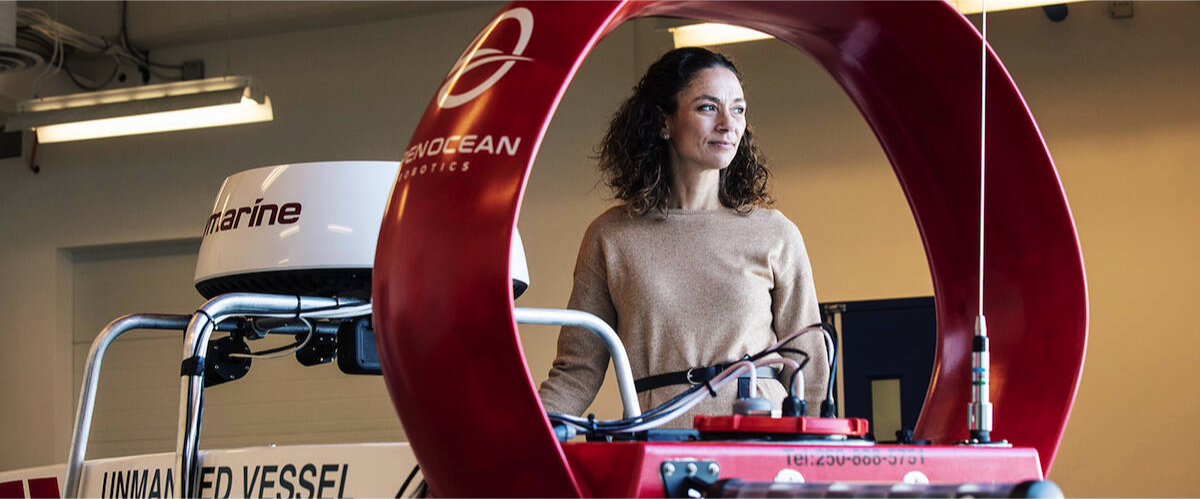This Startup Builds USVs That Collect Data About Oceans
Because most of the ocean’s vast area is far from land, it can be dangerous and expensive for crewed vessels to conduct research expeditions. This spurred Julie Angus to cofound the startup Open Ocean Robotics to design, build, and operate oceangoing uncrewed surface vehicle (USV) drones. She is the company’s CEO.
“Our planet’s oceans are full of information that can help us protect at-risk marine life, allow ships to select more fuel-efficient routes, crack down on illegal fishing, better understand the impacts of climate change, and more,” Angus says. The IEEE member also belongs to the IEEE Oceanic Engineering Society.
The startup offers marine data as a service using its solar-powered Data Xplorer ocean drones, which eliminate the need for traditional crewed vessels. They can travel for months at a time collecting ocean and environmental data.
“Our team will help you plan the mission and execute it from start to finish,” she says.
[*Note: Open Ocean Robotics was named a 2019 IEEE Entrepreneurship Star, previously known as IEEE N3XT® Stars, at Collision 2019. The IEEE Entrepreneurship Stars recognition program identifies competition candidate ventures with engineering-driven innovation at their core that align with the IEEE core purpose to foster technology, innovation, and excellence for the benefit of humanity.]
 The company designs and builds the drone’s hull, deck, and circuit boards. There is a patent pending on the self-righting roll-bar system. The drone is equipped with electro-optical and infrared cameras. Its sensors include hydrophones that can listen to marine life, as well as environmental sensors to measure water temperature, salinity, turbidity, and weather conditions. The USV weighs just over 100 kilograms, and its motor propels it at up to 33.3 kilometers per hour.
The company designs and builds the drone’s hull, deck, and circuit boards. There is a patent pending on the self-righting roll-bar system. The drone is equipped with electro-optical and infrared cameras. Its sensors include hydrophones that can listen to marine life, as well as environmental sensors to measure water temperature, salinity, turbidity, and weather conditions. The USV weighs just over 100 kilograms, and its motor propels it at up to 33.3 kilometers per hour.
“We have 360-degree video streaming, so the operator can use a joystick to remotely drive the boat,” Angus says. “Otherwise, our command-and-control portal can program a vehicle for autonomous activity, such as uploading a route [for] doing a grid survey.” Thanks to the combination of solar cells and lithium batteries, she says, “our boats can operate and travel nonstop for months, without needing refueling or external recharging.”
Open Ocean Robotics has received several awards and recognitions, including being named a 2019 IEEE N3XT Star. The N3XT program showcases engineering-driven founders and entrepreneurial topics.
The company began in the Anguses’ garage on Vancouver Island, B.C., Canada, in 2018. The following year, the company moved to the Vancouver Island Technology Park research and tech center. Today, Open Ocean has more than two dozen full-time employees, plus contractors and part-time staff, bringing the total to just over 30. The company has received more than US$5 million in funding.
Angus knows firsthand how challenging the ocean can be. Her water expeditions throughout the world include five months between 2005 and 2006 when she and her husband rowed from Portugal to Costa Rica. It was the first time a woman had rowed across the Atlantic Ocean from the mainland to mainland. In 2009, the couple cofounded Angus Rowboats, which manufactures rowboats and creates sailboat kits and plans for the recreational market.
“Our boats can operate and travel nonstop for months, without needing refueling or external recharging.”
Angus also brings an academic perspective to her ponderings of the deep. She has a bachelor’s degree in biology and psychology from McMaster University, in Hamilton, Ont., Canada, and a master’s degree in molecular biology from the University of Victoria, in British Columbia.
As of June, Open Ocean Robotics had three Data Xplorers in service, and two more nearly completed. It plans to start manufacturing another 10 later this year.
“We are still primarily doing pilot projects in both Canada and the United States, but we are transitioning into more recurring-revenue contracts,” Angus says.
The startup is eager for new technology such as smaller base stations for low Earth orbit communication satellites when its USV can’t get cellular service. The company also plans to invest in continued advancements in photovoltaic cells and in power storage—and smaller, more energy-efficient sensors.
Although Open Ocean is committed to its maritime focus, “we are not necessarily limiting ourselves to surface vehicles,” Angus says. “I can also imagine having aerial drones or underwater vehicles as part of our data-collection services. For us, the goal is data collection, helping to build an Internet of Things for the sea.”






